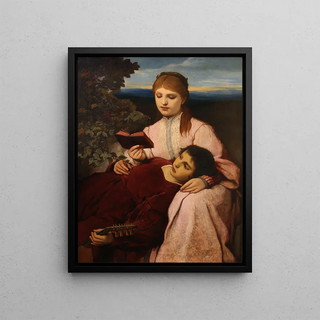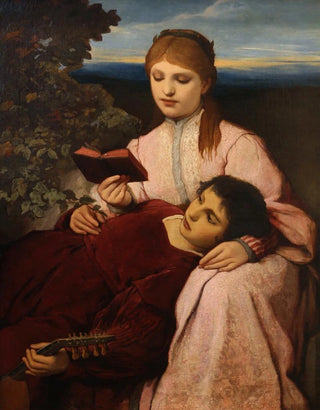Art print | Leisure Hours - Gabriel von Max


View from behind

Frame (optional)
Heures de loisirs - Gabriel von Max – Captivating introduction
In the vast panorama of art history, some works stand out for their ability to capture the very essence of the human condition. "Heures de loisirs" by Gabriel von Max is one of those creations that transcends the simple pictorial frame to evoke a deeper reflection on time, nature, and escape. This piece, imbued with poetry and sensitivity, transports us to a universe where contemplation becomes a true invitation to daydreaming. The scene depicted by the artist immerses us in a suspended moment, where everyday life blends with the beauty of simple moments, thus revealing a subtle dialogue between man and his environment.
Style and uniqueness of the work
Gabriel von Max's style is characterized by delicacy and precision that are uniquely his own. In "Heures de loisirs," vibrant colors and delicate nuances combine to create an atmosphere that is both serene and enchanting. The artist uses soft lighting that caresses the forms, accentuating the almost dreamlike dimension of the scene. The characters, portrayed in natural postures, seem to surrender to the softness of the moment, inviting the viewer to share this intimacy. The composition is carefully orchestrated, with each element having its place and importance, demonstrating undeniable technical mastery. This work stands out not only for its refined aesthetic but also for the depth of its message—a ode to the beauty of leisure moments and the necessity of taking time to savor life.
The artist and his influence
Gabriel von Max, a painter and illustrator of German origin, is an artist whose career deserves exploration. Born in 1840, he managed to establish himself on the European art scene thanks to his unique style and his ability to address various themes, ranging from nature to human psychology. Influenced by the Symbolist movement, Max often explored the relationships between man and nature, seeking to express deep emotions through his works. His innovative approach has inspired many contemporary artists, and his legacy endures to this day. By placing the human experience at the heart of his creation, he managed to create a bridge between art and life,

Matte finish

View from behind

Frame (optional)
Heures de loisirs - Gabriel von Max – Captivating introduction
In the vast panorama of art history, some works stand out for their ability to capture the very essence of the human condition. "Heures de loisirs" by Gabriel von Max is one of those creations that transcends the simple pictorial frame to evoke a deeper reflection on time, nature, and escape. This piece, imbued with poetry and sensitivity, transports us to a universe where contemplation becomes a true invitation to daydreaming. The scene depicted by the artist immerses us in a suspended moment, where everyday life blends with the beauty of simple moments, thus revealing a subtle dialogue between man and his environment.
Style and uniqueness of the work
Gabriel von Max's style is characterized by delicacy and precision that are uniquely his own. In "Heures de loisirs," vibrant colors and delicate nuances combine to create an atmosphere that is both serene and enchanting. The artist uses soft lighting that caresses the forms, accentuating the almost dreamlike dimension of the scene. The characters, portrayed in natural postures, seem to surrender to the softness of the moment, inviting the viewer to share this intimacy. The composition is carefully orchestrated, with each element having its place and importance, demonstrating undeniable technical mastery. This work stands out not only for its refined aesthetic but also for the depth of its message—a ode to the beauty of leisure moments and the necessity of taking time to savor life.
The artist and his influence
Gabriel von Max, a painter and illustrator of German origin, is an artist whose career deserves exploration. Born in 1840, he managed to establish himself on the European art scene thanks to his unique style and his ability to address various themes, ranging from nature to human psychology. Influenced by the Symbolist movement, Max often explored the relationships between man and nature, seeking to express deep emotions through his works. His innovative approach has inspired many contemporary artists, and his legacy endures to this day. By placing the human experience at the heart of his creation, he managed to create a bridge between art and life,






